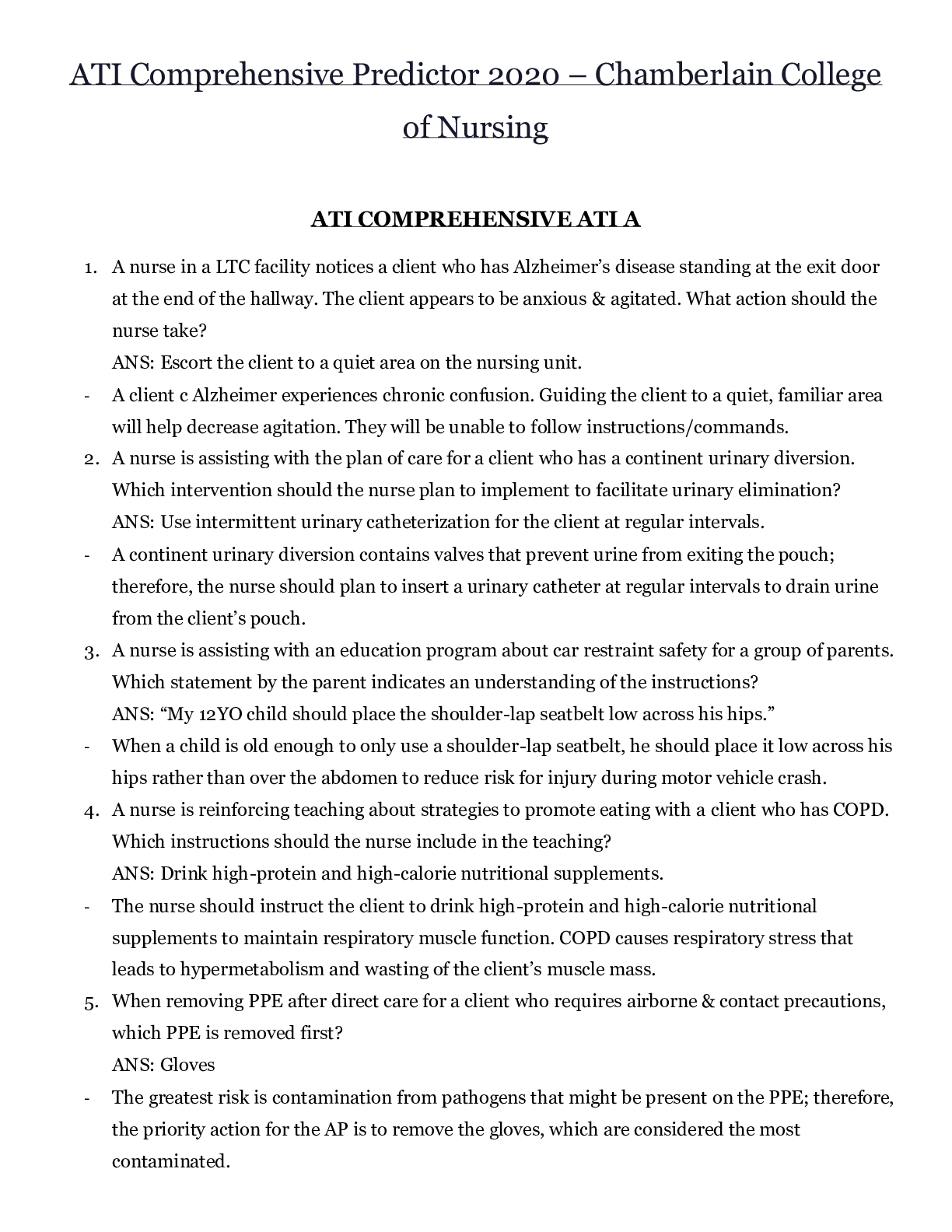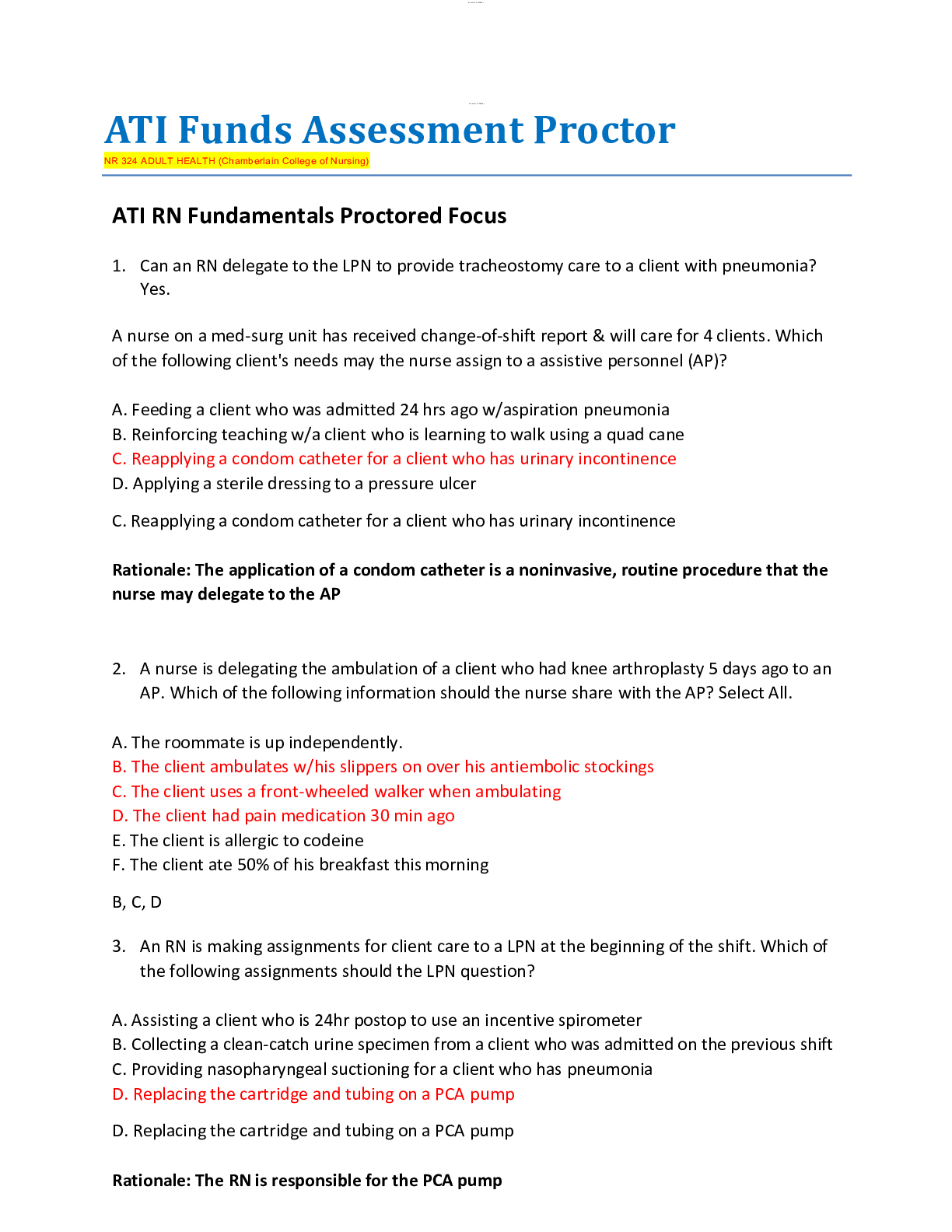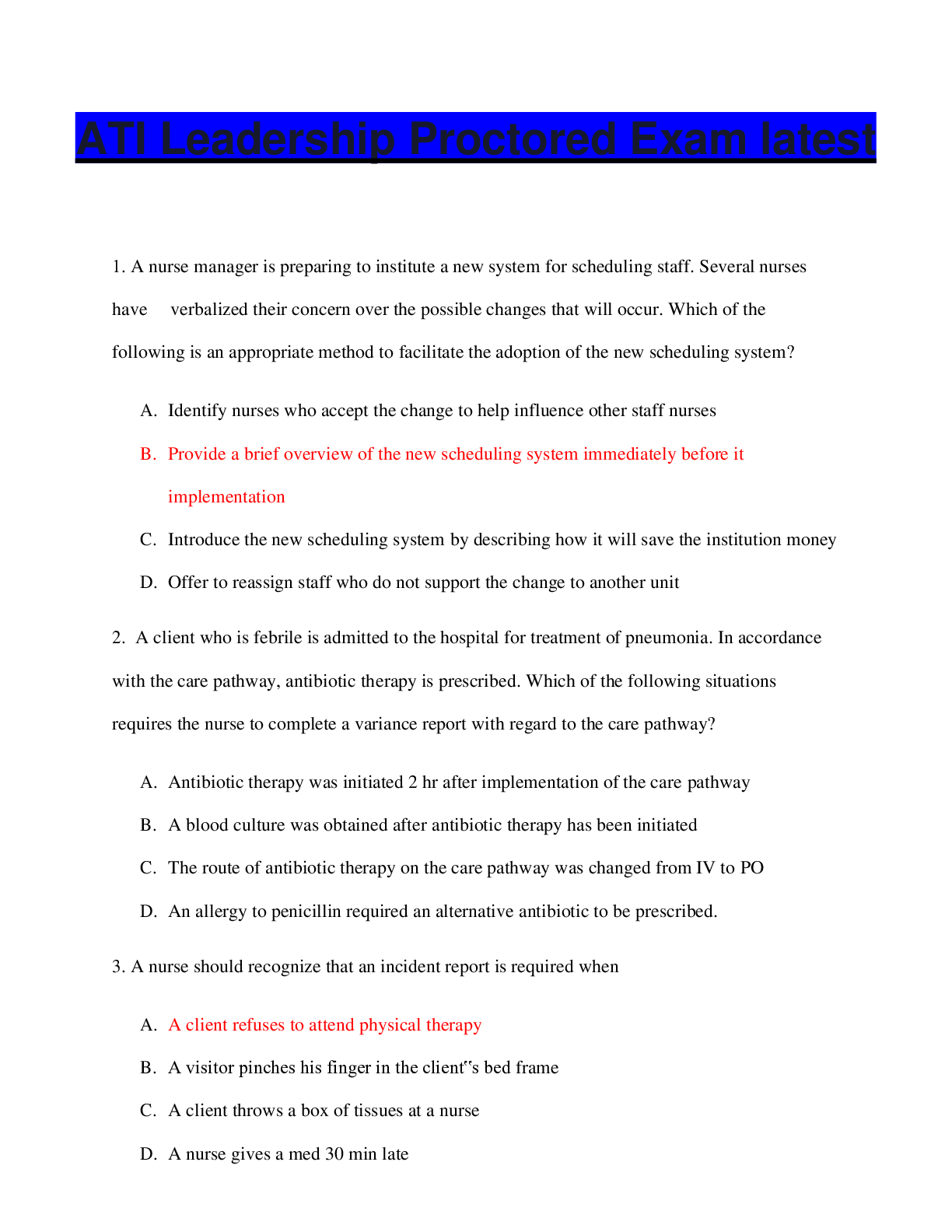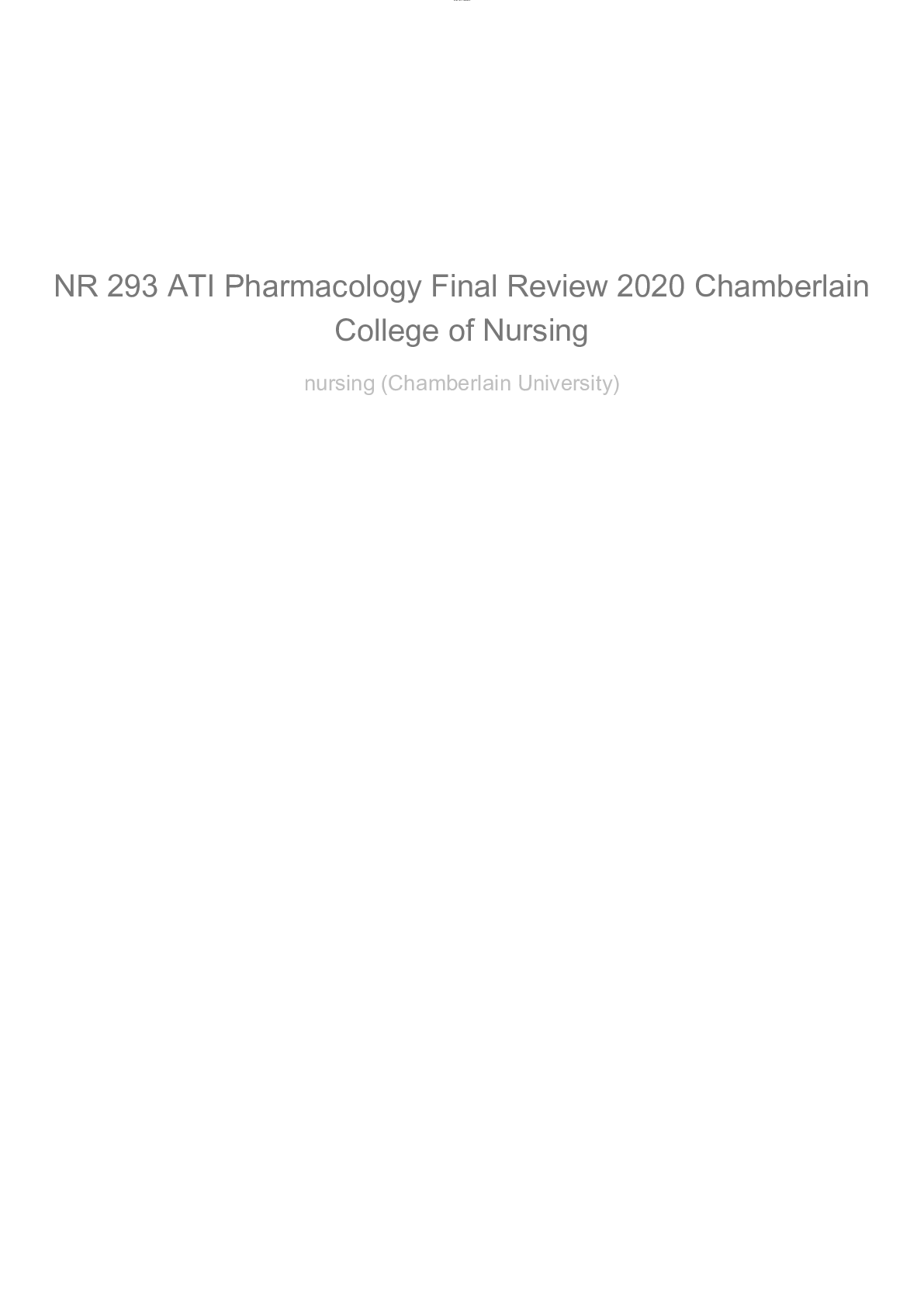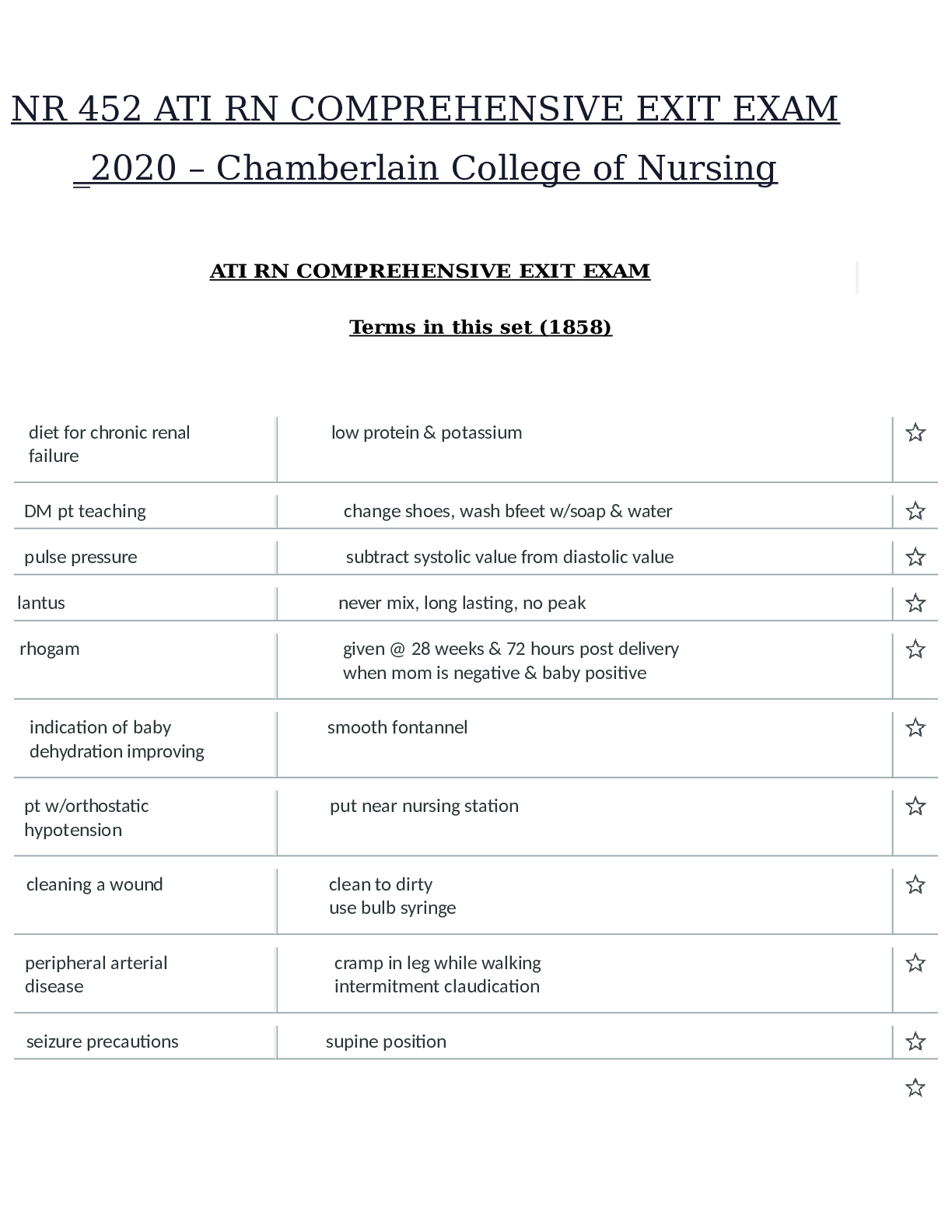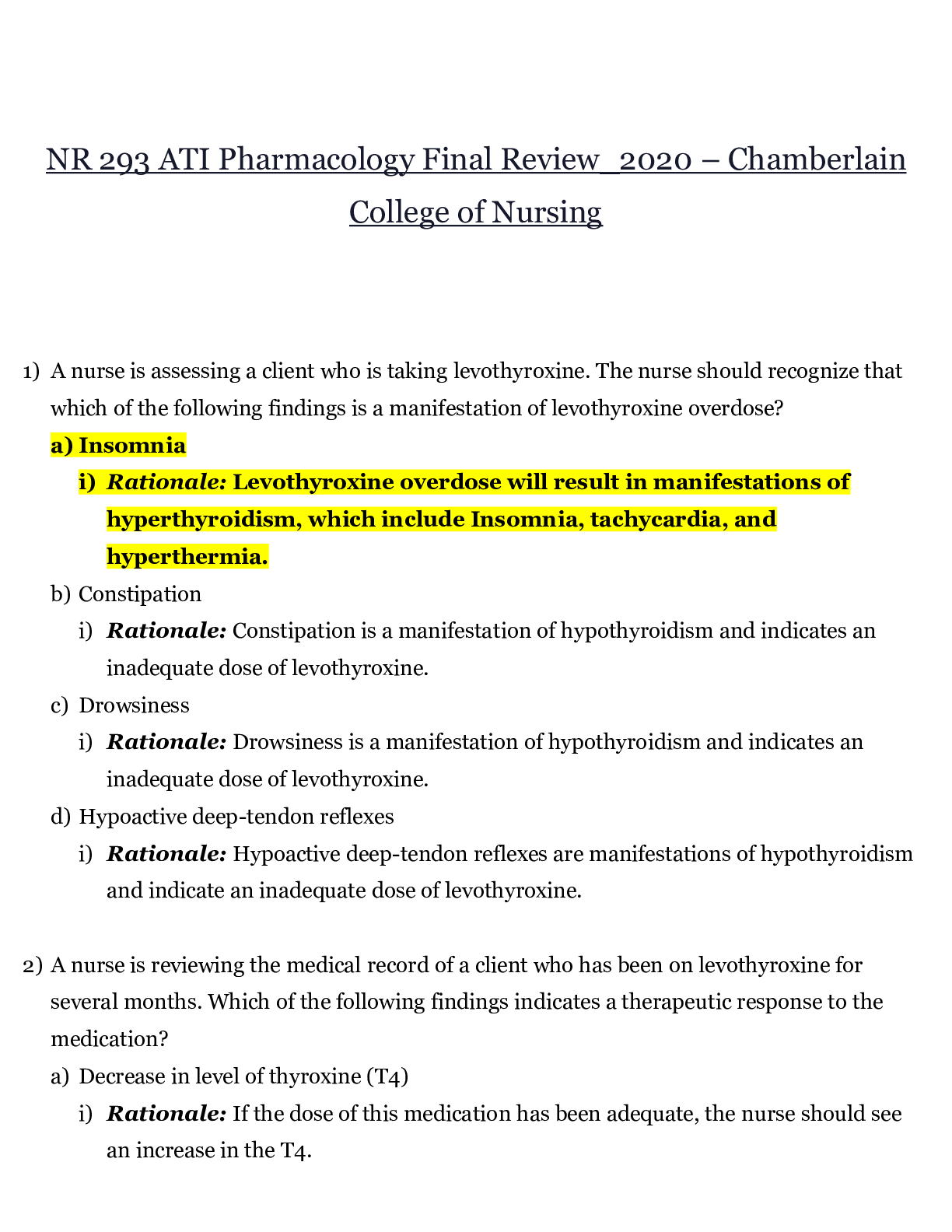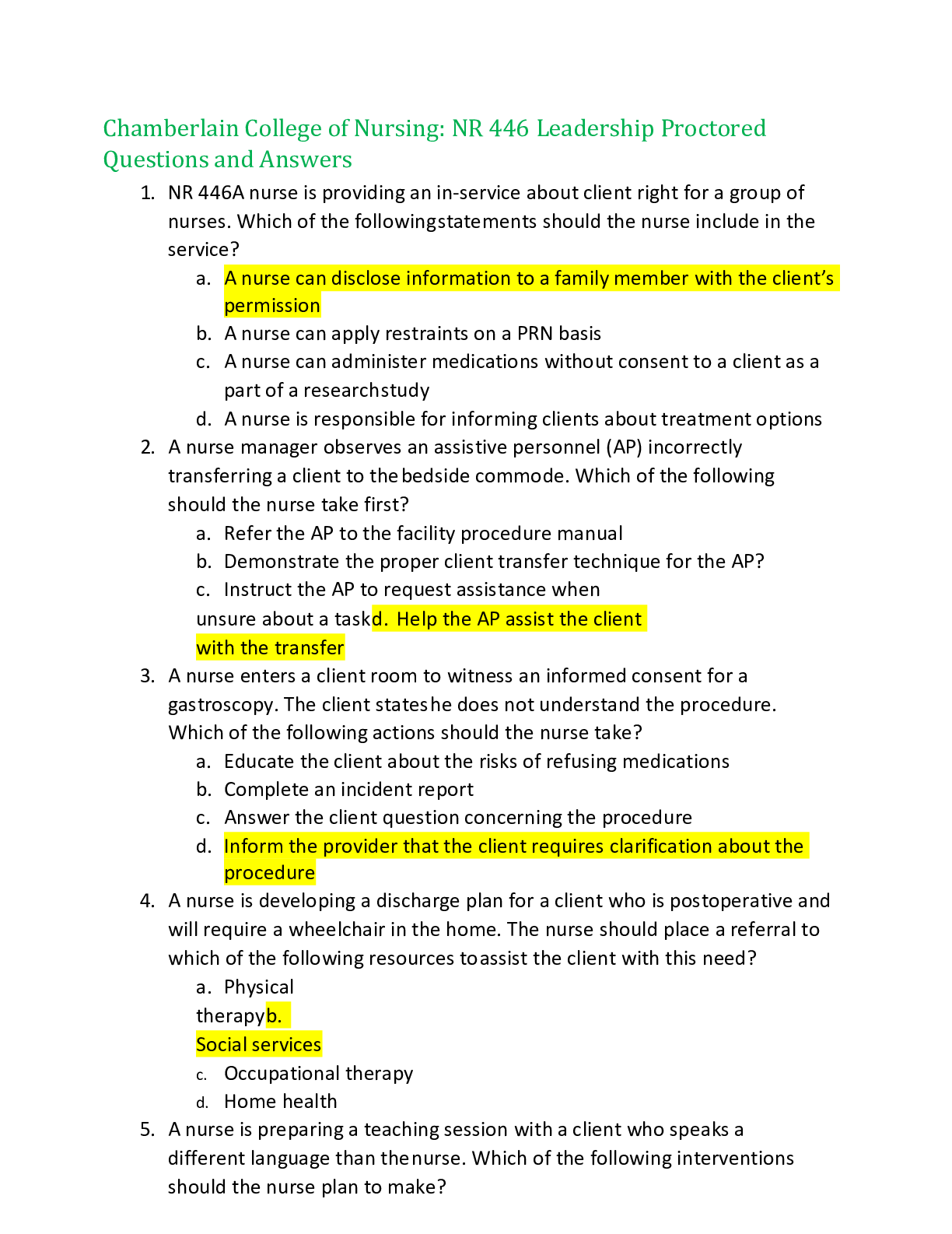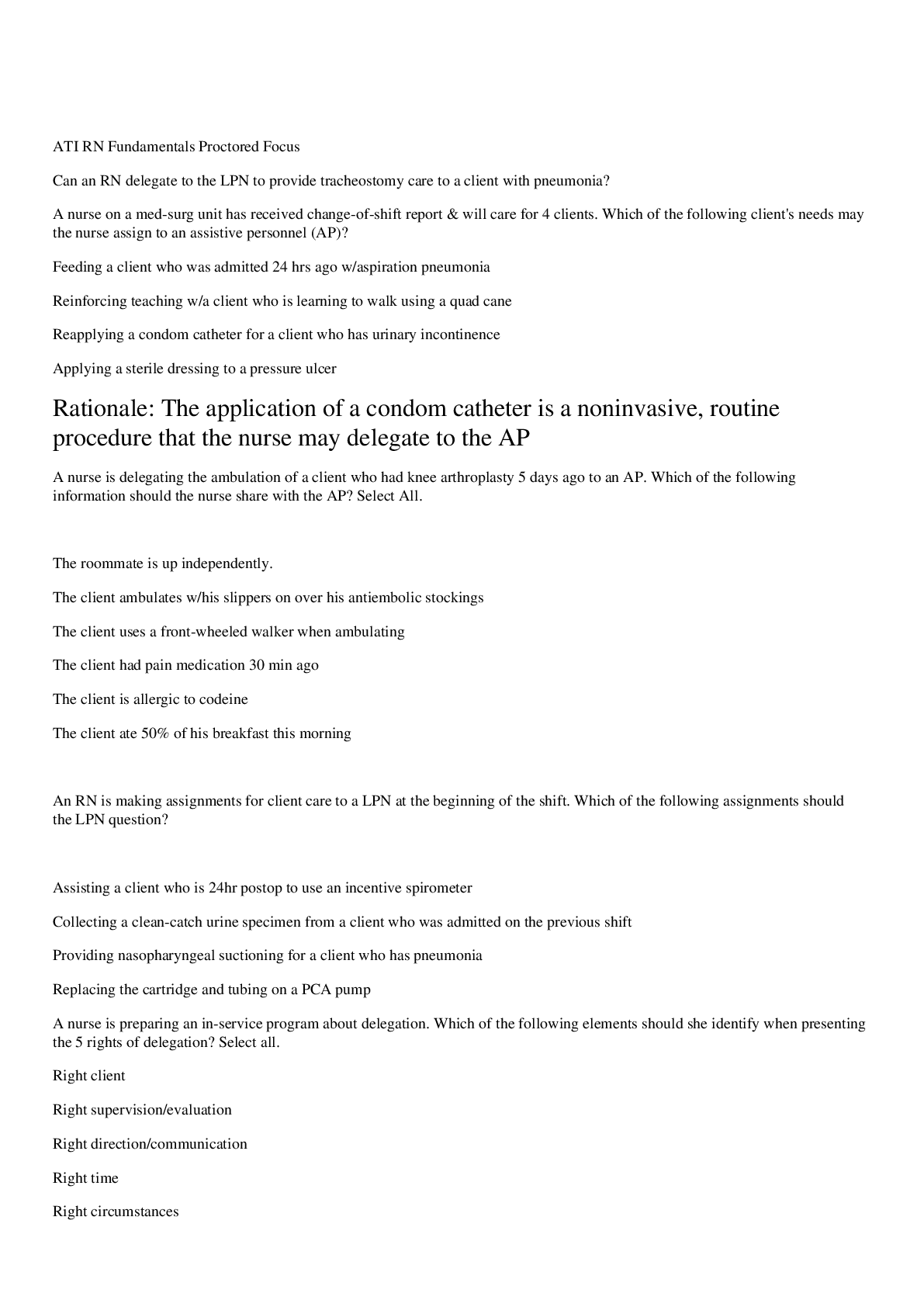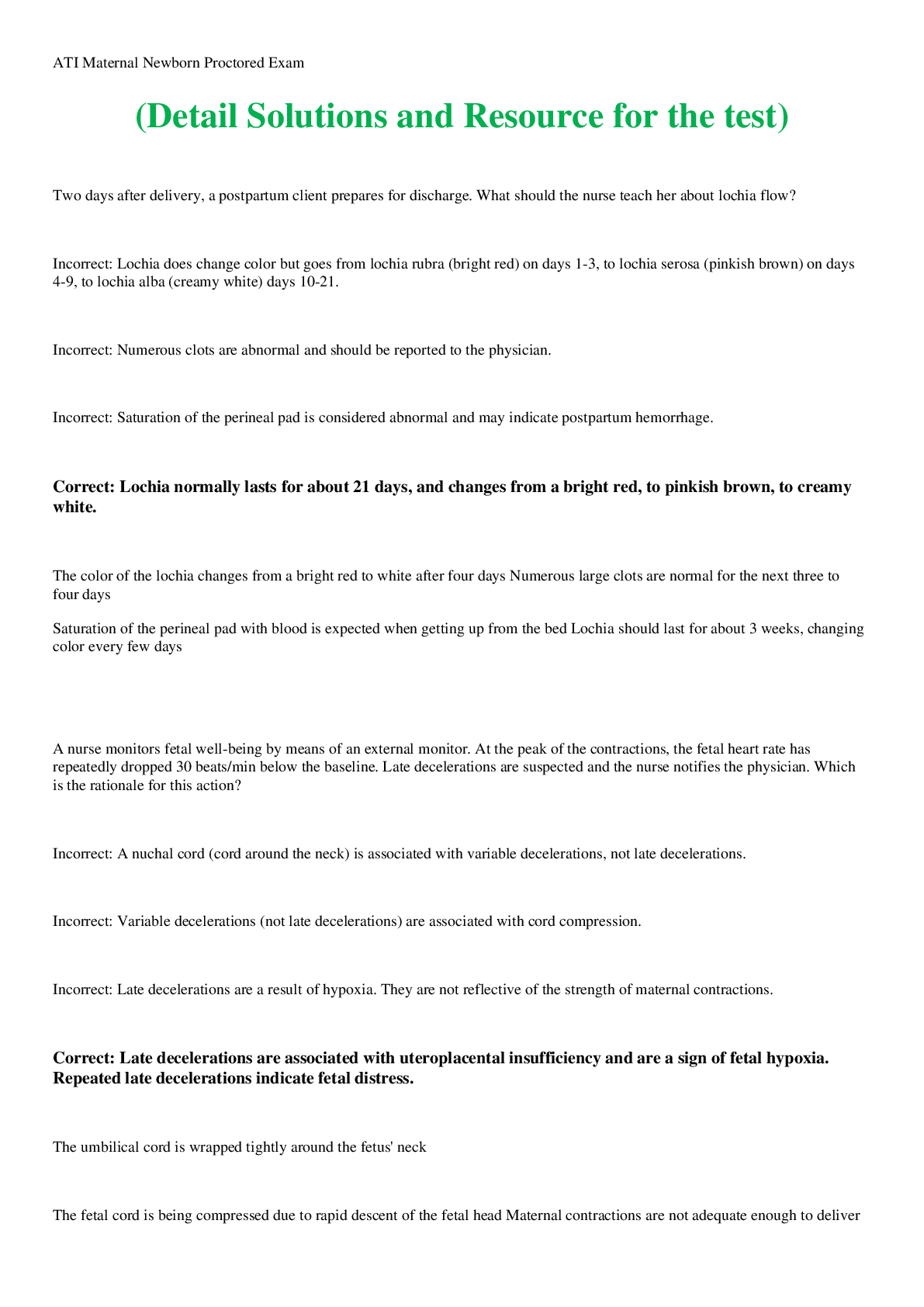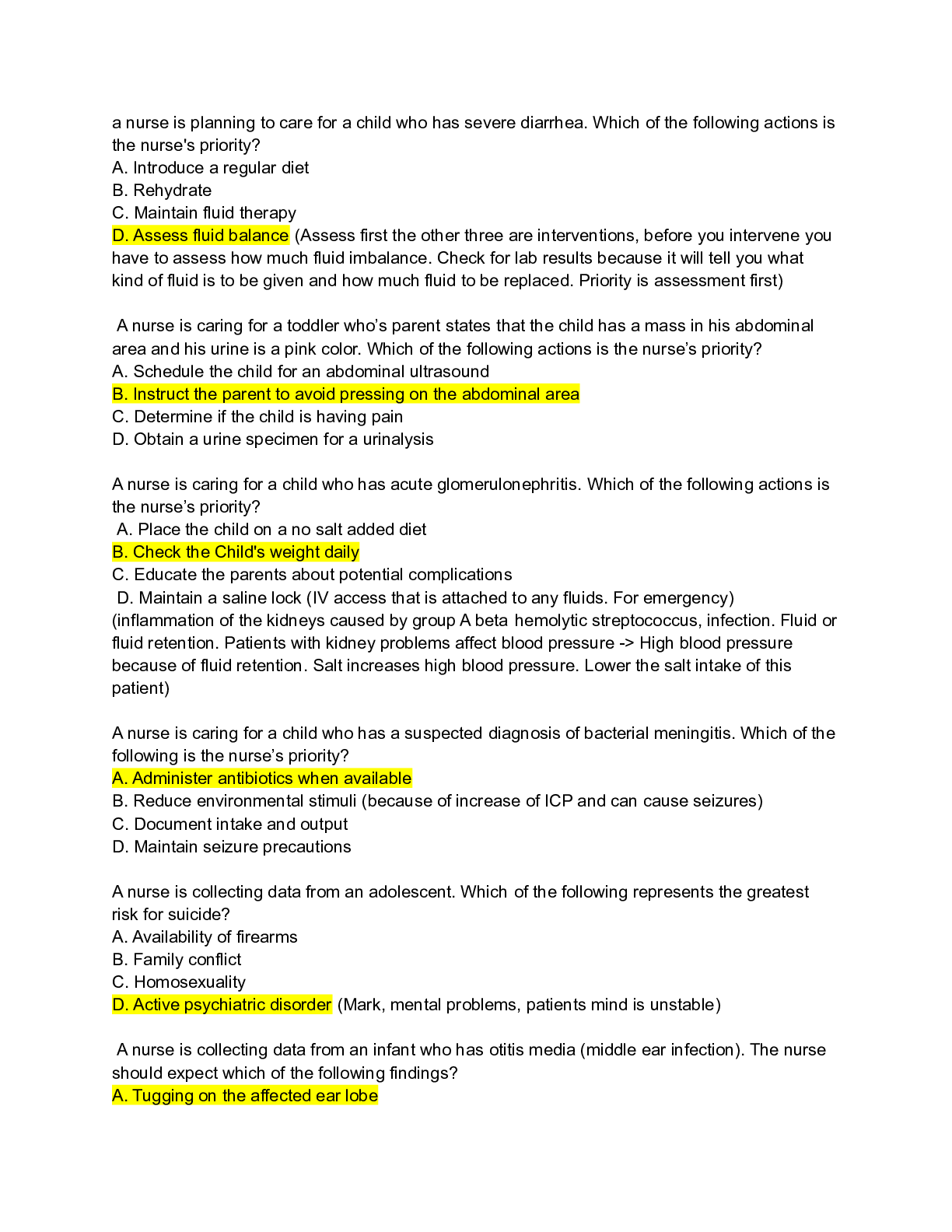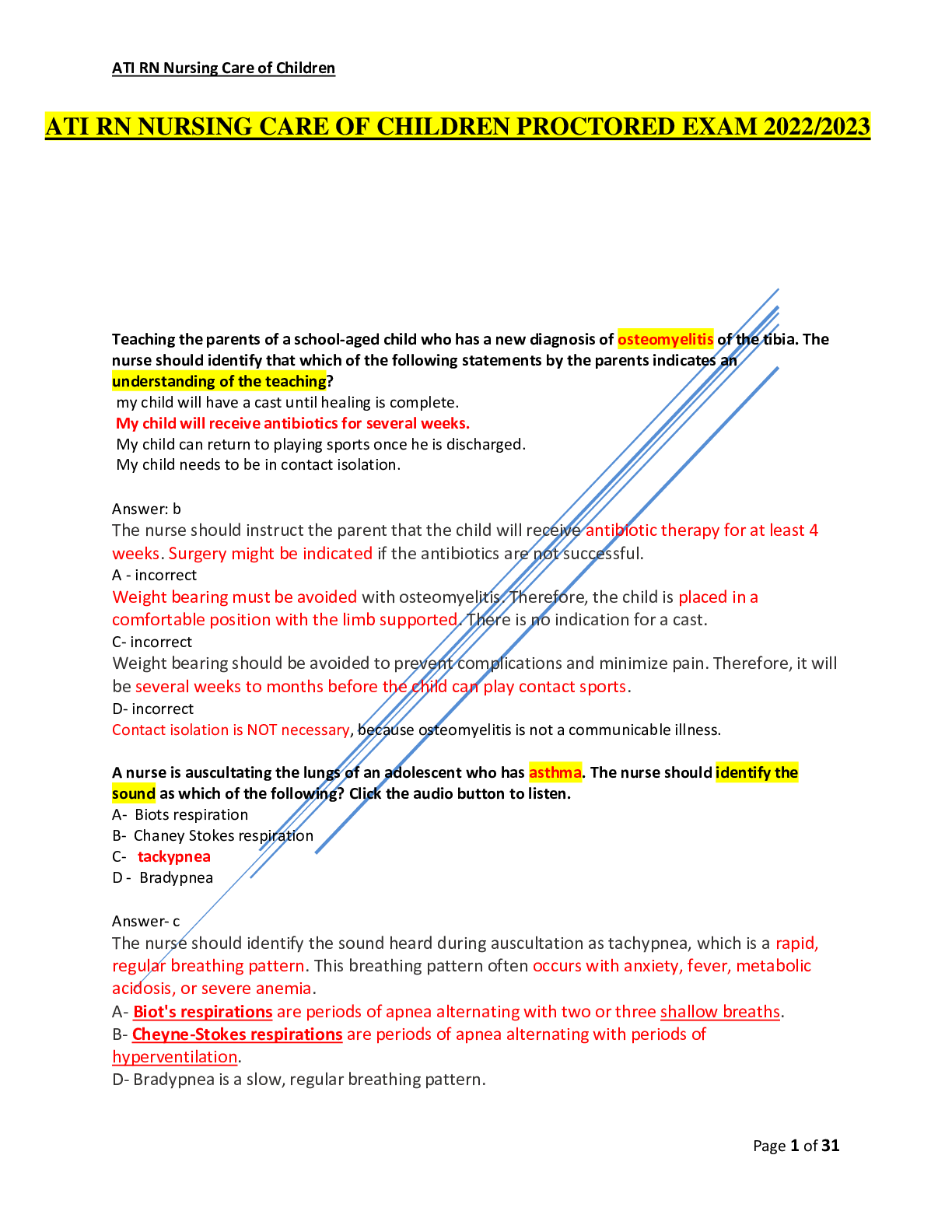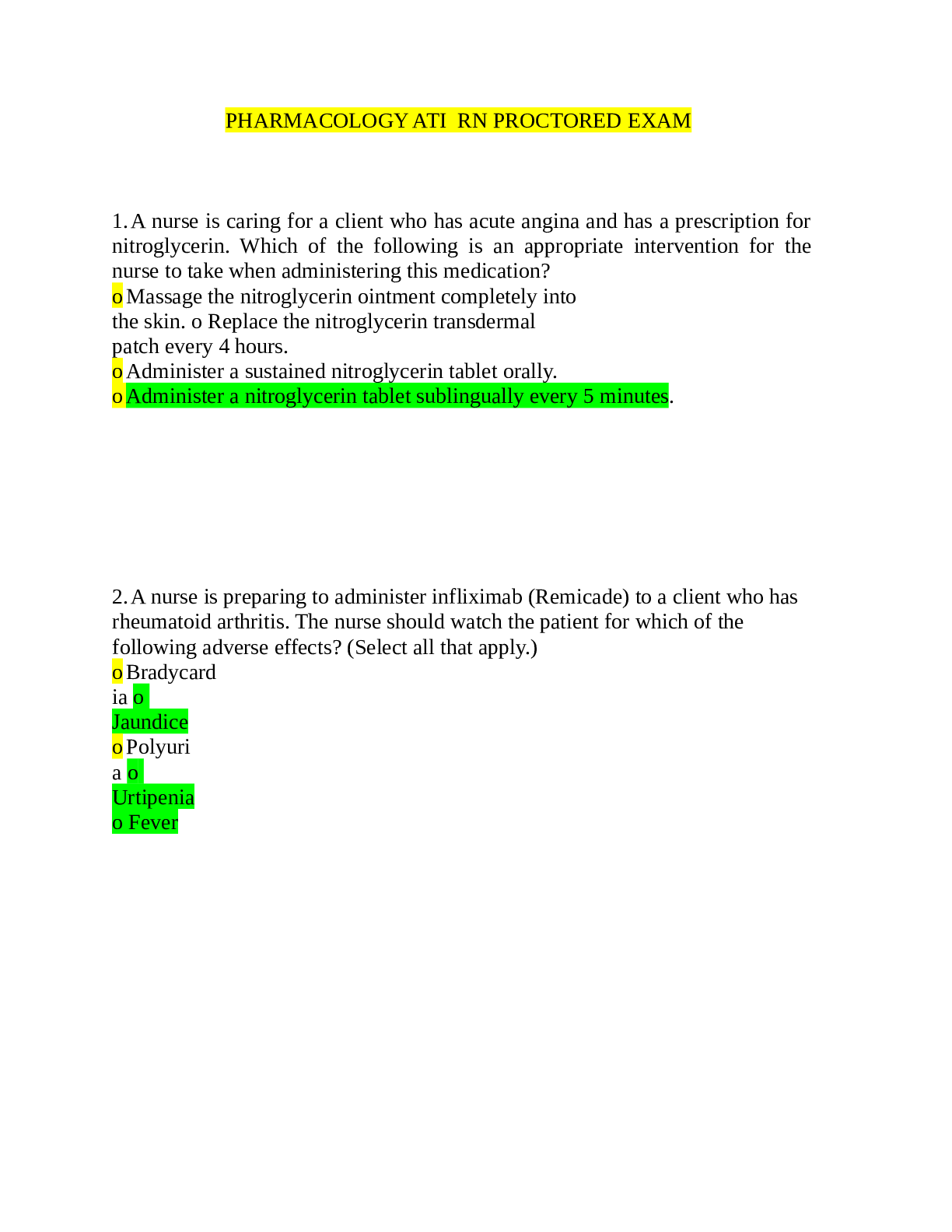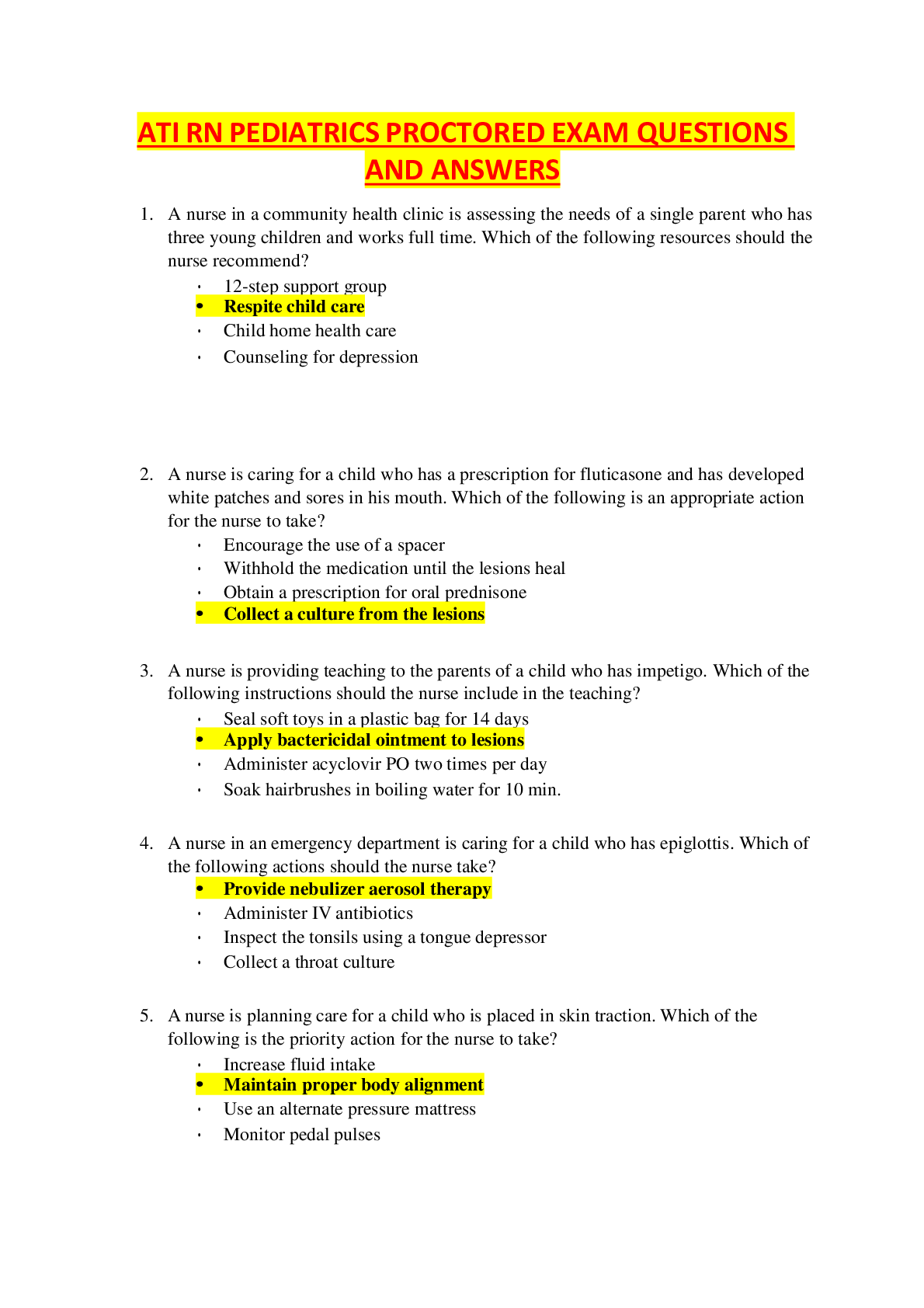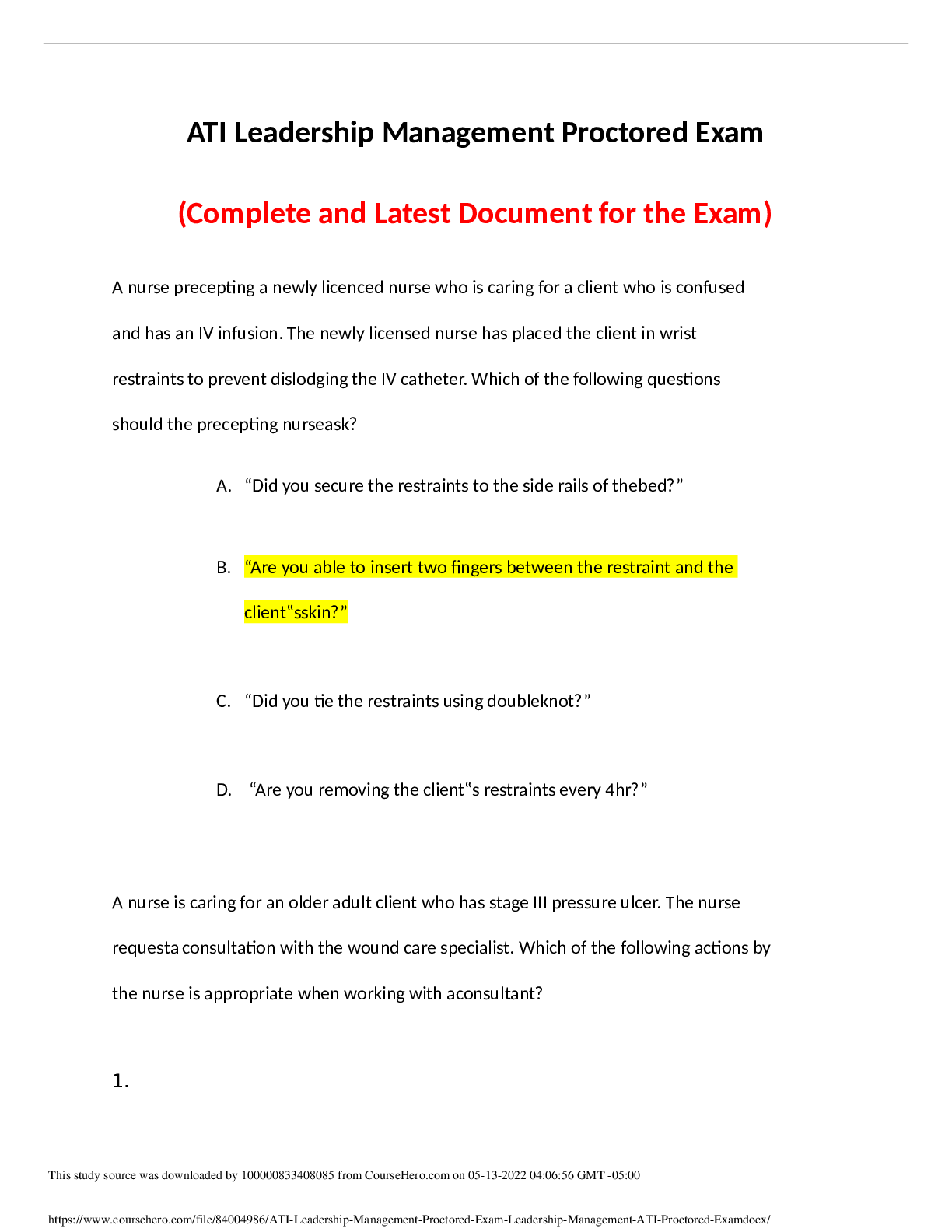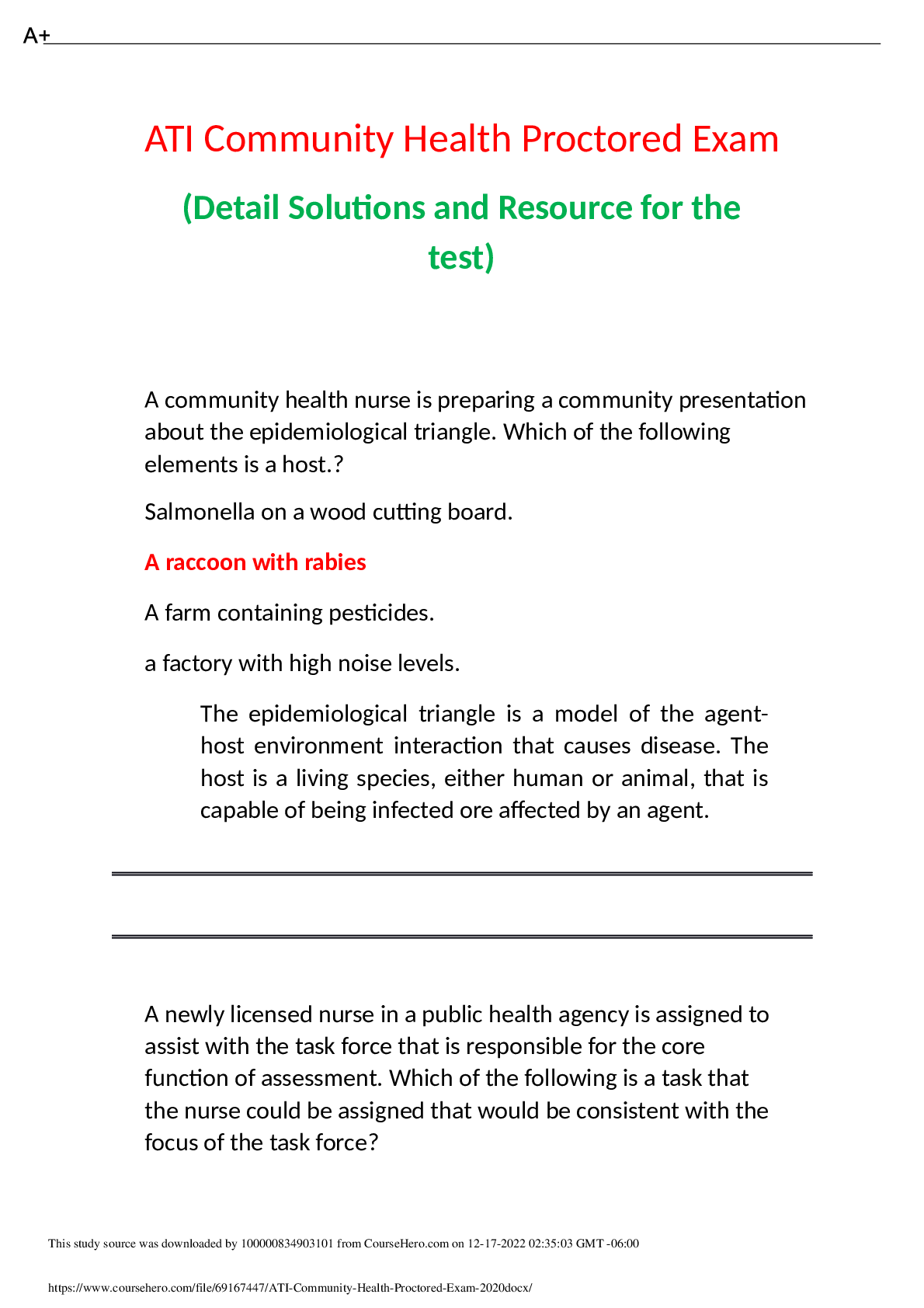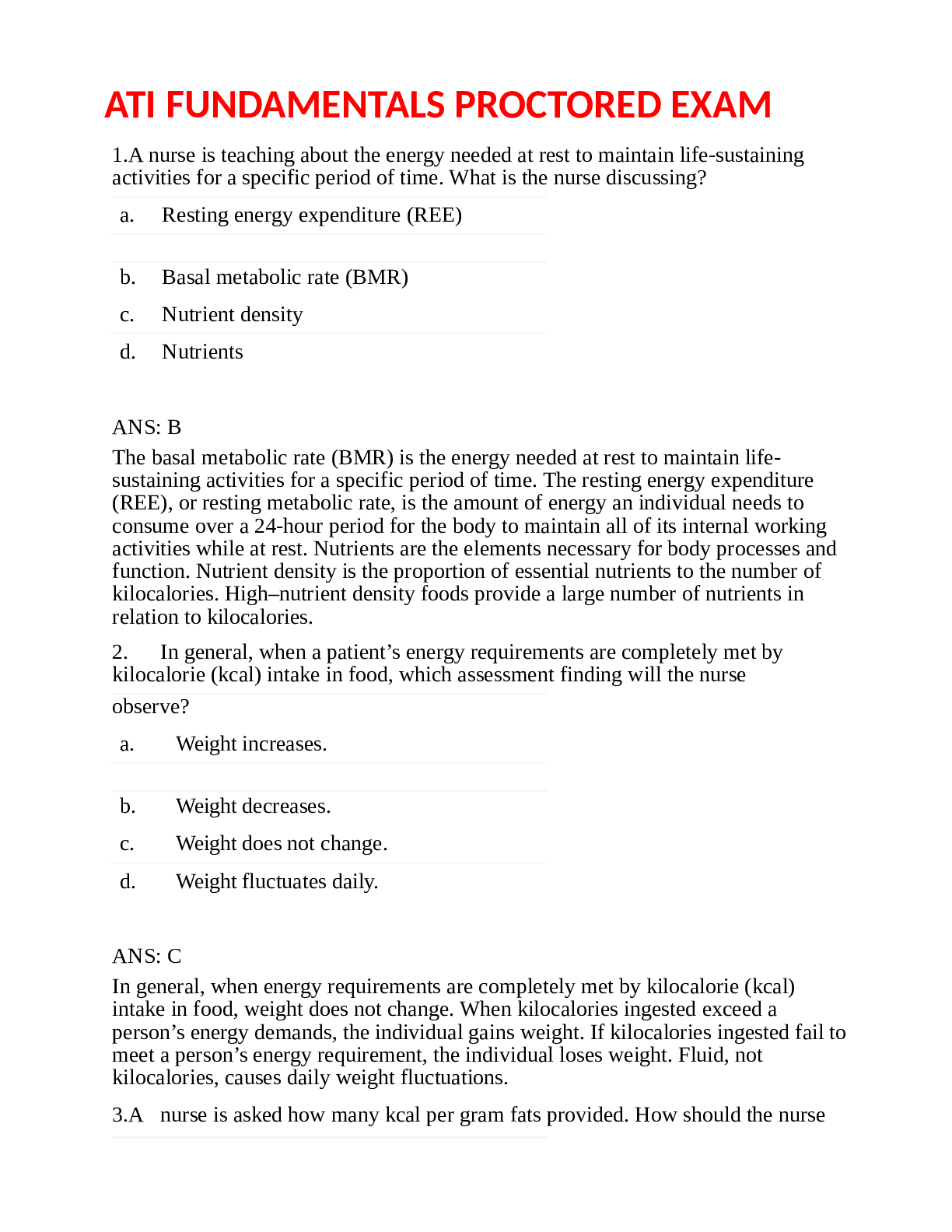*NURSING > ATI > ATI Targeted Med-Surg Assessment_ Fluid and Electrolyte and Acid/Base balance Q&A. NR 324 Adult Hea (All)
ATI Targeted Med-Surg Assessment_ Fluid and Electrolyte and Acid/Base balance Q&A. NR 324 Adult Health I_ Chamberlain College of Nursing
Document Content and Description Below
NR 324 Adult Health I_ Chamberlain College of Nursing -ATI Targeted Med-Surg Assessment_ Fluid and Electrolyte and Acid/Base balance. A nurse is assessing a client who is using PCA following a thora... cotomy. The client is SOB, appears restless, and has a RR of 28/min. The client's ABG results are pH 7.52, PaO2 89 mmHg, PaCO2 28 mmHg, and HCO3- 24 mEq/L. Which of the following actions should the nurse take? a. Instruct the client to cough forcefully. b. Assist the client with ambulation. c. Provide calming interventions. d. Discontinue the PCA. that he is "feeling weak in the legs." Which of the following actions should the nurse take first? a. Monitor the client's bowel sounds. b. Review the client's daily laboratory results. c. Auscultate the client's lungs. d. Palpate the client's peripheral pulses.A nurse is caring for a client who is receiving furosemide daily. During the morning assessment, the client tells the nurse t While reviewing a client's lab results, a nurse notes a serum calcium level of 8.0 mg/dL. Which of the following actions should the nurse take? a. Implement seizure precautions. b. Administer phosphate. c. Initiate diuretic therapy. d. Prepare the client for hemodialysis. A nurse is assessing a client who has a phosphorus level of 2.4 mg/dL. Which of the following findings should the nurse expect? a. Hepatic failure. b. Abdominal pain. c. Slow peripheral pulses. d. Increase in cardiac output. A nurse is reviewing the lab report of a client who has fluid volume excess. Which of the following lab values should the nurse expect? a. Hemoglobin 20 g/dL. b. Hematocrit 34%. c. BUN 25 mg/dL. d. Urine specific gravity 1.050. A nurse is reviewing the medical record of a client who has DM and is receiving regular insulin by continuous IV infusion to treat DKA. Which of the following findings should the nurse report to the provider? a. Urine output of 30 mL/hr. b. Blood glucose of 180 mg/dL. c. Serum K+ 3.0 mEq/L. d. BUN 18 mg/dL A nurse is evaluating a client who is receiving IV fluids to treat isotonic dehydration. Which of the following lab findings indicates that the fluid therapy has been effective? a. BUN 26 mg/dL. b. Serum Na+ 138 mEq/L. c. Hct 56% d. Urine specific gravity 1.035 A nurse is caring for a client who reports difficulty breathing and tingling in both hands. His RR is 36/min and he appears very restless. Which of the following values should the nurse anticipate to be outside the expected reference range is the client is experiencing respiratory alkalosis? a. PaO2 b. PaCO2 c. Sodium d. Bicarbonate A nurse is assessing a client who has dehydration. Which of the following assessments is the priority? a. Skin turgor. b. Urine output. c. Weight. d. Mental status. A nurse is assessing a client who has a serum calcium level of 8.1 mg/dL. Which of the following is the priority for the nurse to assess? a. Deep-tendon reflexes. b. Cardiac rhythm. c. Peripheral sensation. d. Bowel sounds. A nurse is providing teaching to a client who has heart failure and is receiving furosemide. Which of the following foods should the nurse recommend as containing the greatest amount of potassium? a. 1/2 cup chopped celery. b. 1 cup plain yogurt. c. 1 slice whole grain bread. d. 1/2 cup cooked tofu. A nurse is preparing to administer oral potassium for a client who has a potassium level of 5.5 mEq/L. Which of the following actions should the nurse take first? a. Administer a hypertonic solution. b. Repeat the potassium level. c. Withhold the medication. d. Monitor for paresthesia. A nurse is caring for a client who requires NG suctioning. Which of the following sets of lab results indicates that the client has metabolic alkalosis? a. pH 7.51, PaO2 94 mmHg, PaCO2 36 mmHg, HCO3- 31 mEq/L b. pH 7.48, PaO2 89 mmHg, PaCO2 30 mmHg, HCO3- 26 mEq/L c. pH 7.31, PaO2 77 mmHg, PaCO2 52 mmHg, HCO3- 23 mEq/L d. pH 7.26, PaO2 84 mmHg, PaCO2 38 mmHg, HCO3- 20 mEq/L A nurse is caring for a client who has dehydration and is receiving IV fluids. When assessing for complications, the nurse should recognize which of the following manifestations as a sign of fluid overload? a. Increased urine specific gravity. b. Hypoactive bowel sounds. c. Bounding peripheral pulses. d. Decreased respiratory rate. A nurse is caring for a client who is experiencing respiratory distress as a result of pulmonary edema. Which of the following actions should the nurse take first? a. Assist with intubation. b. Initiate high-flow oxygen therapy. c. Administer a rapid-acting diuretic. d. Provide cardiac monitoring. A nurse is admitting a client who takes 40 mg furosemide daily for heart failure and has experienced 3 days of vomiting. The nurse suspects hypokalemia. Which of the following medications should the nurse prepare to administer? a. Sodium polystyrene sulfonate 30 g/day. b. 0.9% sodium chloride with 10 mEq/L of potassium chloride at 100 mL/hr. c. Bumetanide 8 mg/day. d. 100 mL of dextrose 10% in water with 10 units of insulin. A nurse is admitting a client who has status asthmaticus. The client's ABG results are pH 7.32, PaO2 74 mmHg, PaCO2 56 mmHg, and HCO3- 26 mEq/L. The nurse should interpret these lab values as which of the following imbalances? a. Respiratory acidosis. b. Respiratory alkalosis. c. Metabolic acidosis. d. Metabolic alkalosis. A nurse is caring for a client who requires continuous cardiac monitoring. The nurse identifies a prolonged PR interval and a widened QRS complex. Which of the following lab values supports this finding? a. Sodium 152 mEq/L b. Chloride 102 mEq/L c. Magnesium 1.8 mEq/L d. Potassium 6.1 mEq/L A nurse is providing dietary teaching to a client who has kidney disease. Which of the following food choices should the nurse include in the teaching as containing the lowest amount of magnesium? a. 1 large hard-boiled egg. b. 1 cup bran cereal. c. 1/2 cup almonds. d. 1 cup cooked spinach. A nurse is assessing a client who has hypomagnesemia. Which of the following findings should the nurse expect? a. Hyperactive deep-tendon reflexes. b. Increased bowel sounds. c. Drowsiness. d. Decreased blood pressure. A nurse is reviewing the ABG results for four clients. Which of the following findings should the nurse identify as metabolic acidosis? a. pH 7.51, PaO2 94 mmHg, PaCO2 38 mmHg, HCO3- 29 mEq/L b. pH 7.48, PaO2 89 mmHg, PaCO2 30 mmHg, HCO3- 24 mEq/L c. pH 7.36, PaO2 77 mmHg, PaCO2 52 mmHg, HCO3- 26 mEq/L d. pH 7.26, PaO2 84 mmHg, PaCO2 38 mmHg, HCO3- 20 mEq/L A nurse is providing teaching for a client who has venous insufficiency of the lower extremities. Which of the following statements by the client indicates an understanding of the teaching? a. "If my stockings feel tight, I'll just roll them down for awhile." b. "I'll put on my elastic stockings at the first sign of swelling." c. "When I sit down to watch television, I'll be sure to put my feet up." A nurse is caring for a client who has a sodium level of 155 mEq/L. Which of the following IV fluids should the nurse anticipate the provider to prescribe? a. Dextrose 5% in 0.9% sodium chloride. b. Dextrose 5% in lactated Ringer's. c. 3% NaCl. d. 0.45% NaCl. A nurse is teaching nutritional strategies to a client who has a low serum calcium level and an allergy to milk. Which of the following statements by the client indicates an understanding of the teaching? a. "I will eat more cheese because I can't drink milk." b. "I need to avoid foods with vitamin D because I am allergic to milk." c. "I will stop taking my calcium supplements if they irritate my stomach." d. "I will add broccoli and kale to my diet." A nurse is assessing a client who has hyperkalemia. Which of the following findings should the nurse expect? a. Decreased muscle strength. b. Decreased gastric motility. c. Increased heart rate. d. Increased blood pressure. A nurse is assessing a client who has respiratory acidosis. Which of the following findings should the nurse expect? a. Hypotension b. Peripheral edema c. Facial flushing d. Hyperreflexia A nurse is planning care for a client who has experienced excessive fluid loss. Which of the following interventions should the nurse include in the plan of care? (Select all that apply) a. Administer IV fluids to the client evenly over 24 hr. b. Provide the client with a salt substitute. c. Assess the client for pitting edema. d. Encourage the client to rise slowly when standing up. e. Weigh the client every 8 hr. A nurse is planning care for a client who has a serum potassium level of 3.0 mEq/L. The nurse should plan to monitor the client for which of the following findings? a. Hyperactive deep-tendon reflexes. b. Orthostatic hypotension. c. Rapid, deep respirations. d. Strong, bounding pulse. A nurse is assessing a client who is receiving hydrochlorothiazide and notes that the client is confused and lethargic. Which of the following lab values should the nurse report to the provider? a. Sodium 128 mEq/L b. Potassium 4.8 mEq/L c. Calcium 9.1 mg/dL d. Magnesium 2.0 mEq/L A nurse is providing teaching for a client who is at risk for developing respiratory acidosis following surgery. Which of the following statements by the client indicates an understanding of the teaching? a. "I should conserve energy by limiting my physical activity." b. "I will wait until my pain is at least six out of ten before I use the PCA." c. "I will limit my daily fluid intake to 2-3 glasses." d. "I will use the incentive spirometer every hour." [Show More]
Last updated: 9 months ago
Preview 1 out of 12 pages
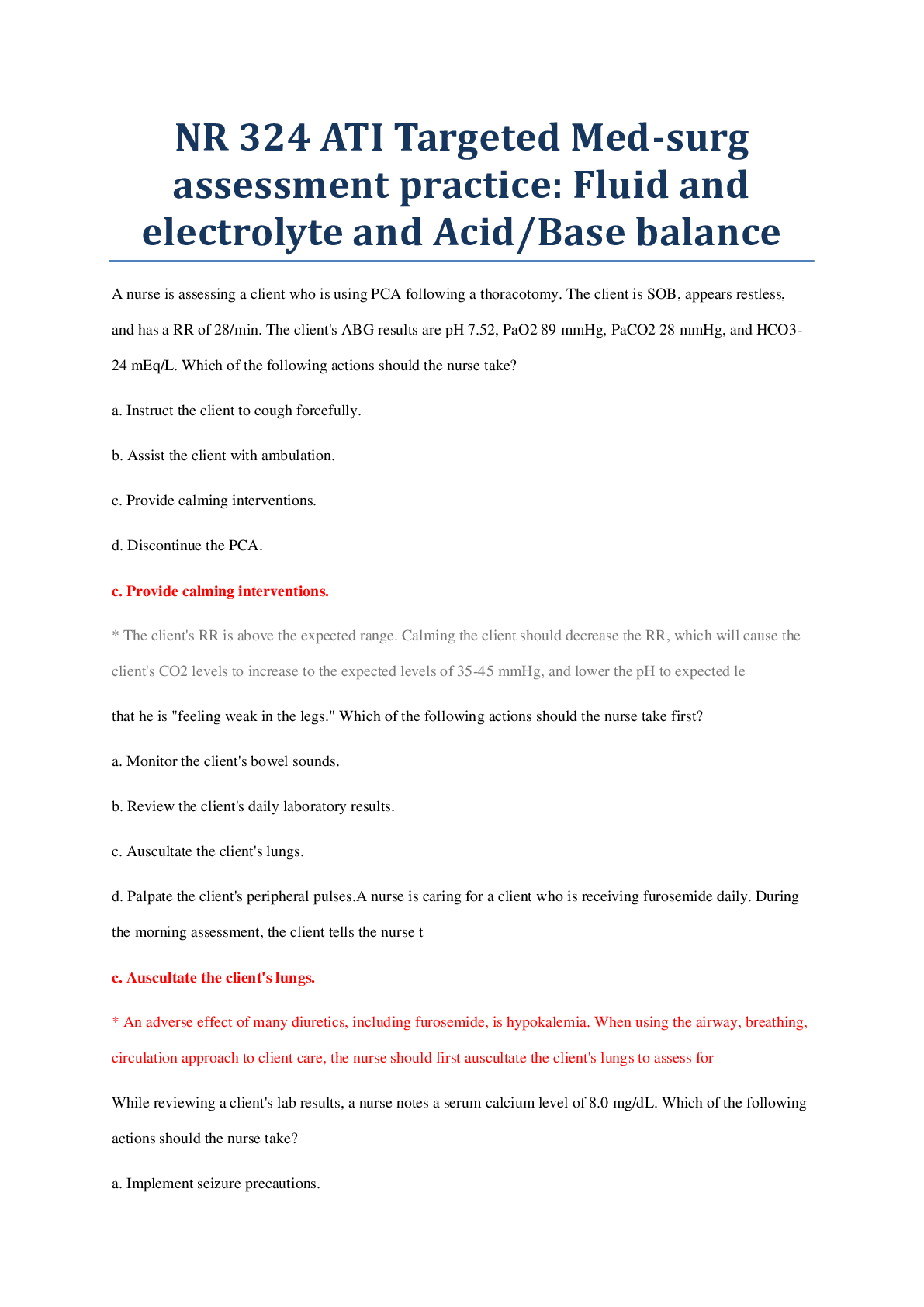
Reviews( 0 )
Document information
Connected school, study & course
About the document
Uploaded On
Feb 18, 2020
Number of pages
12
Written in
Additional information
This document has been written for:
Uploaded
Feb 18, 2020
Downloads
1
Views
89

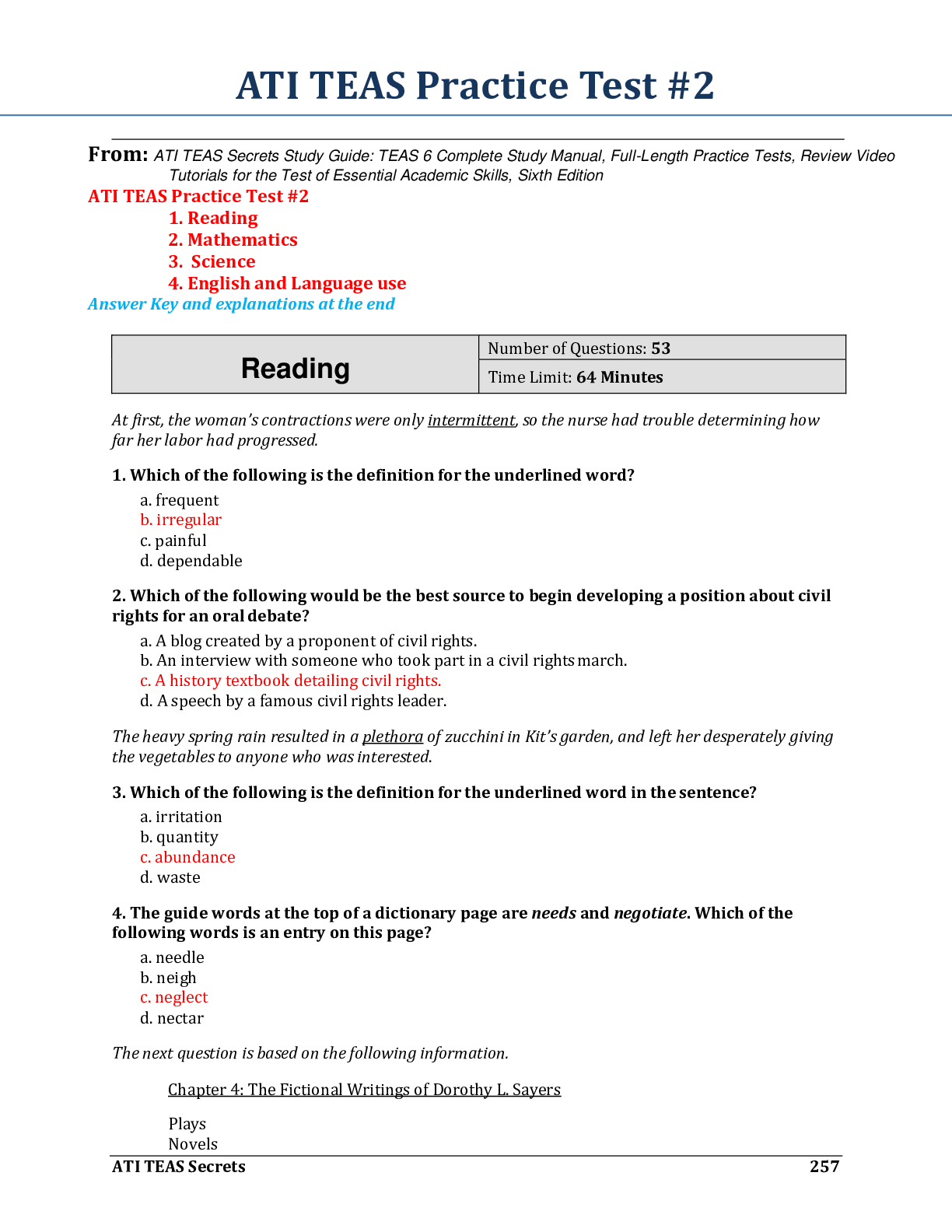
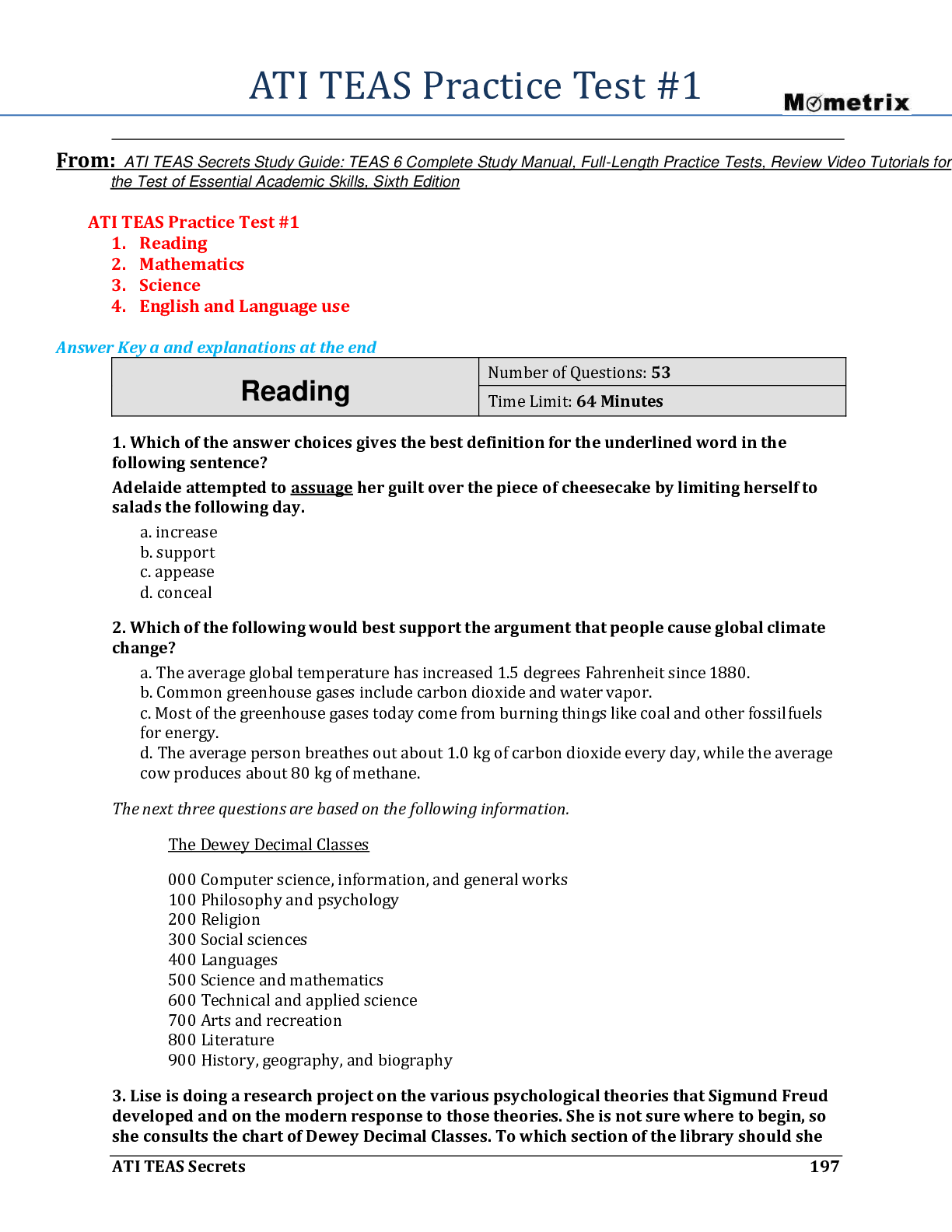
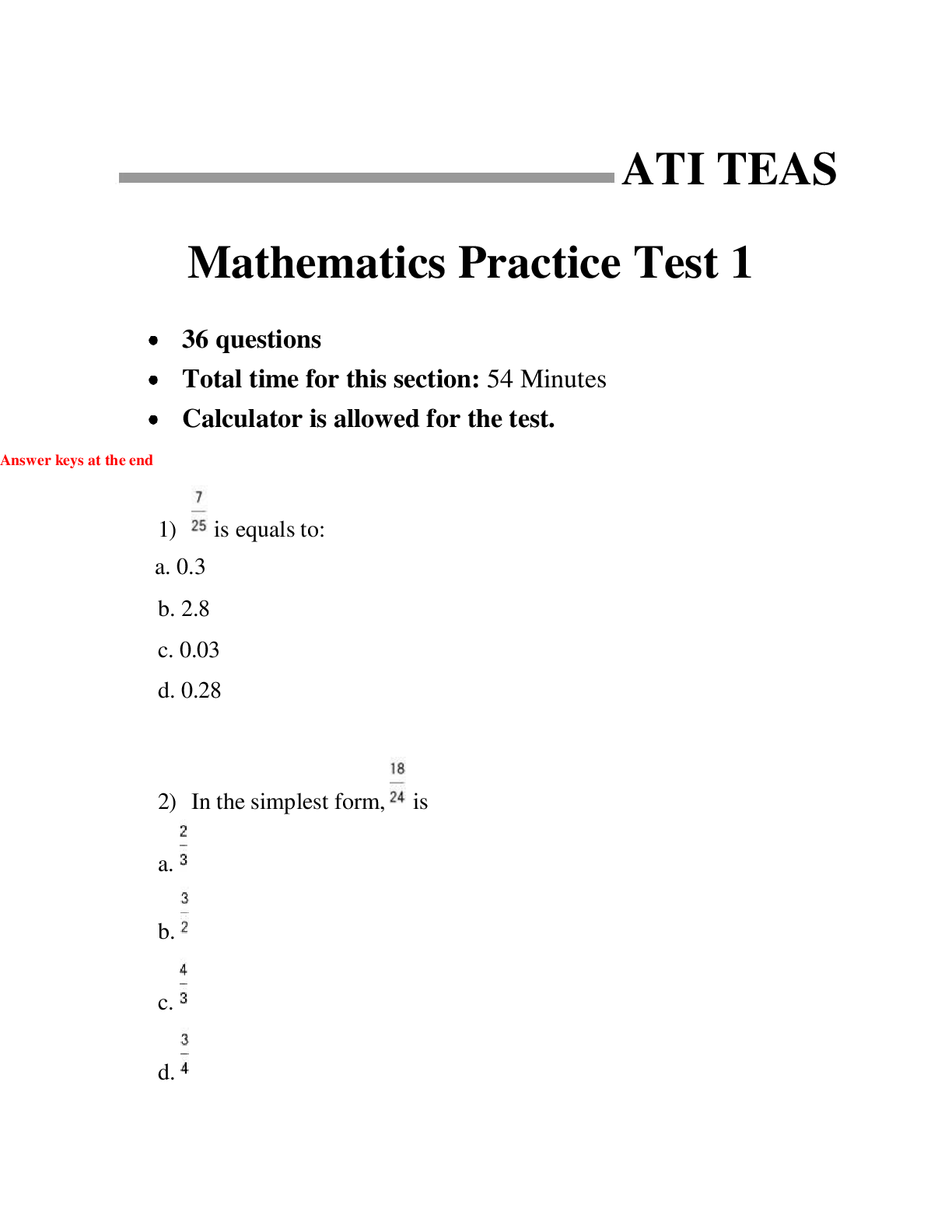
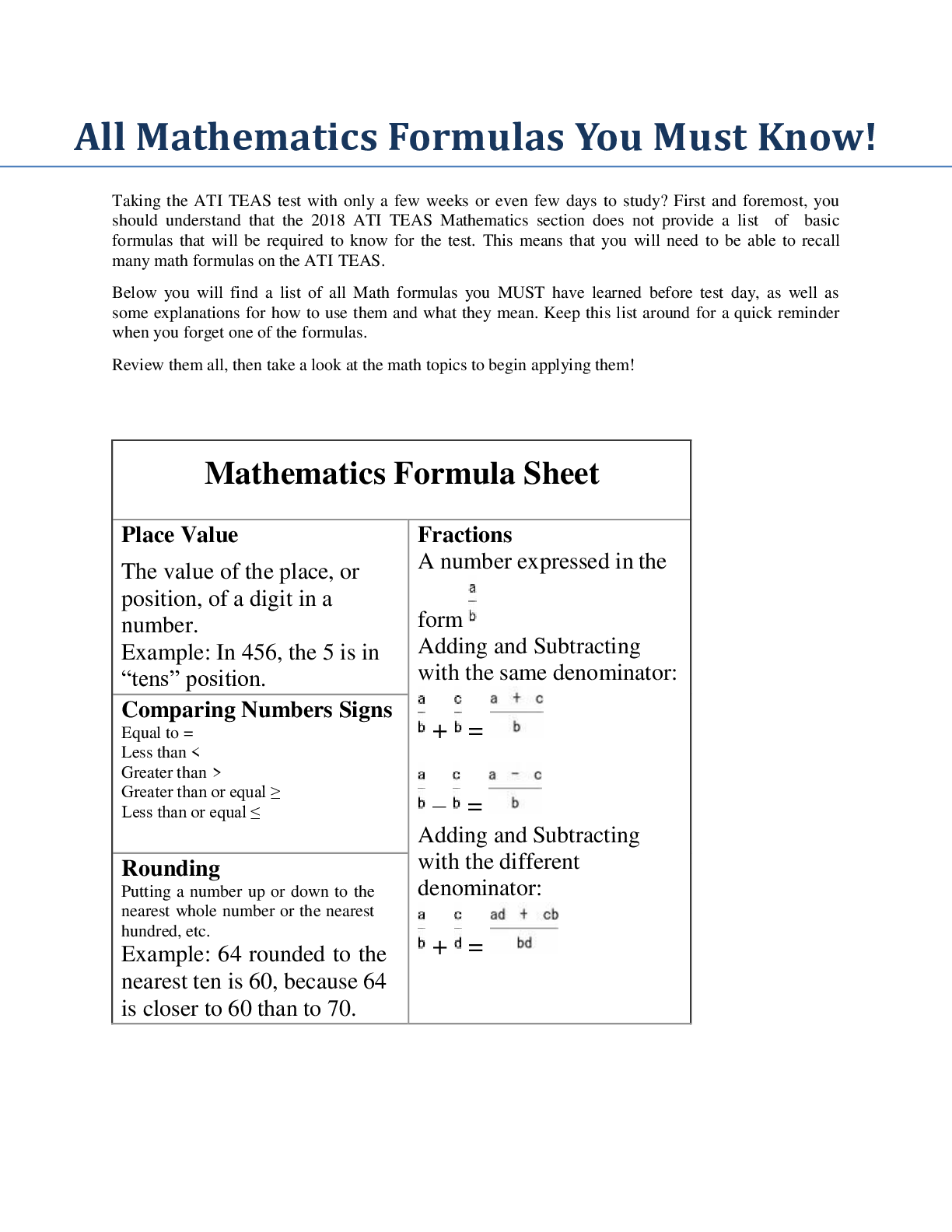
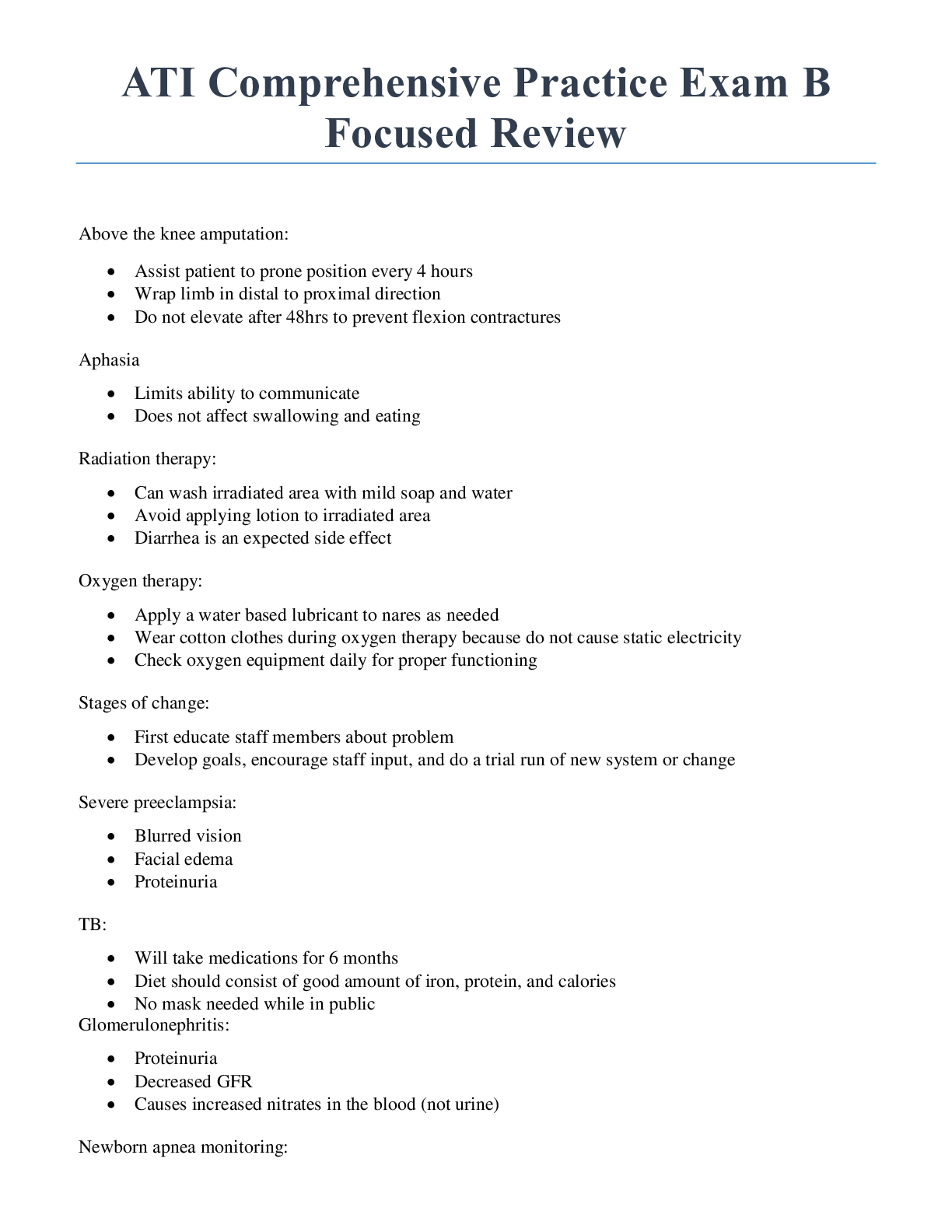

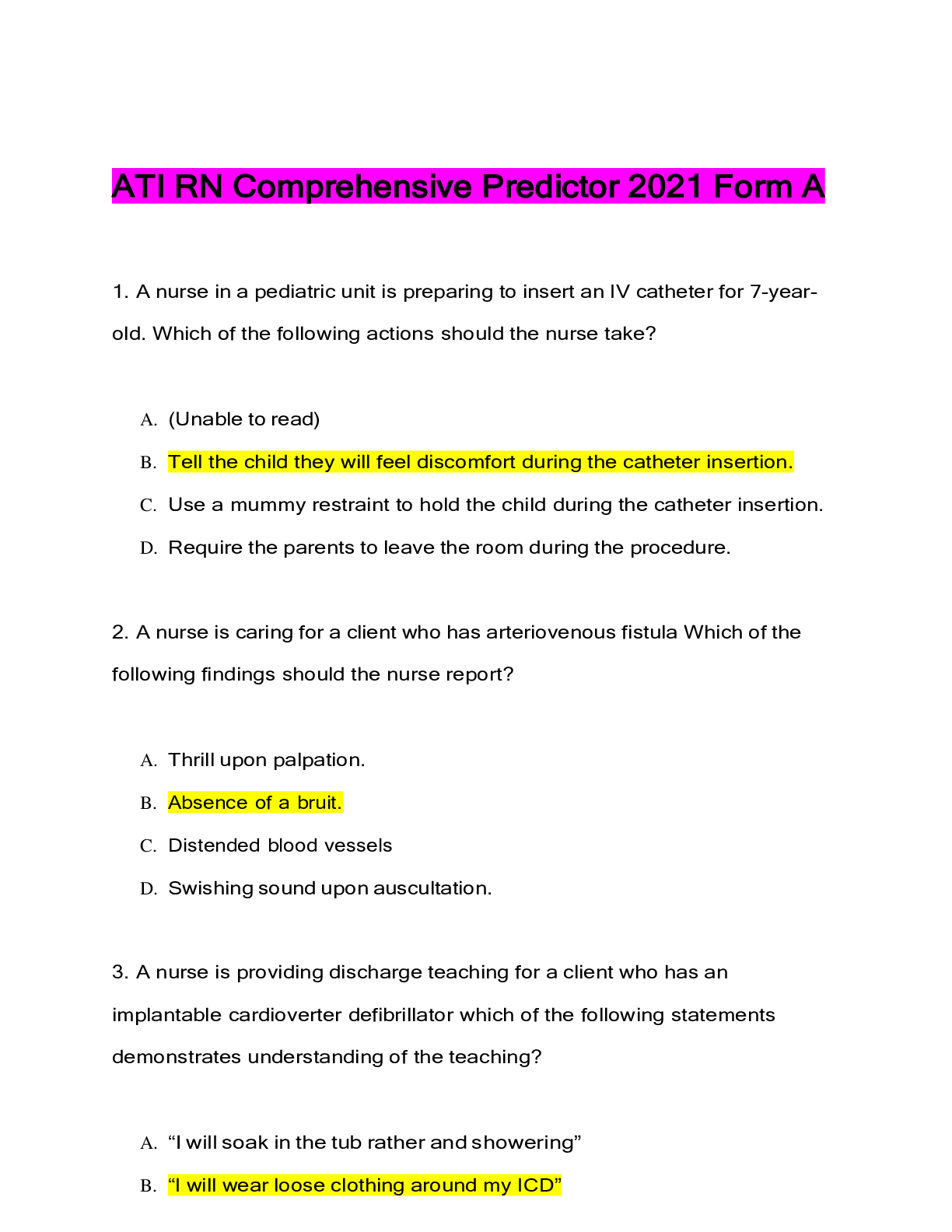
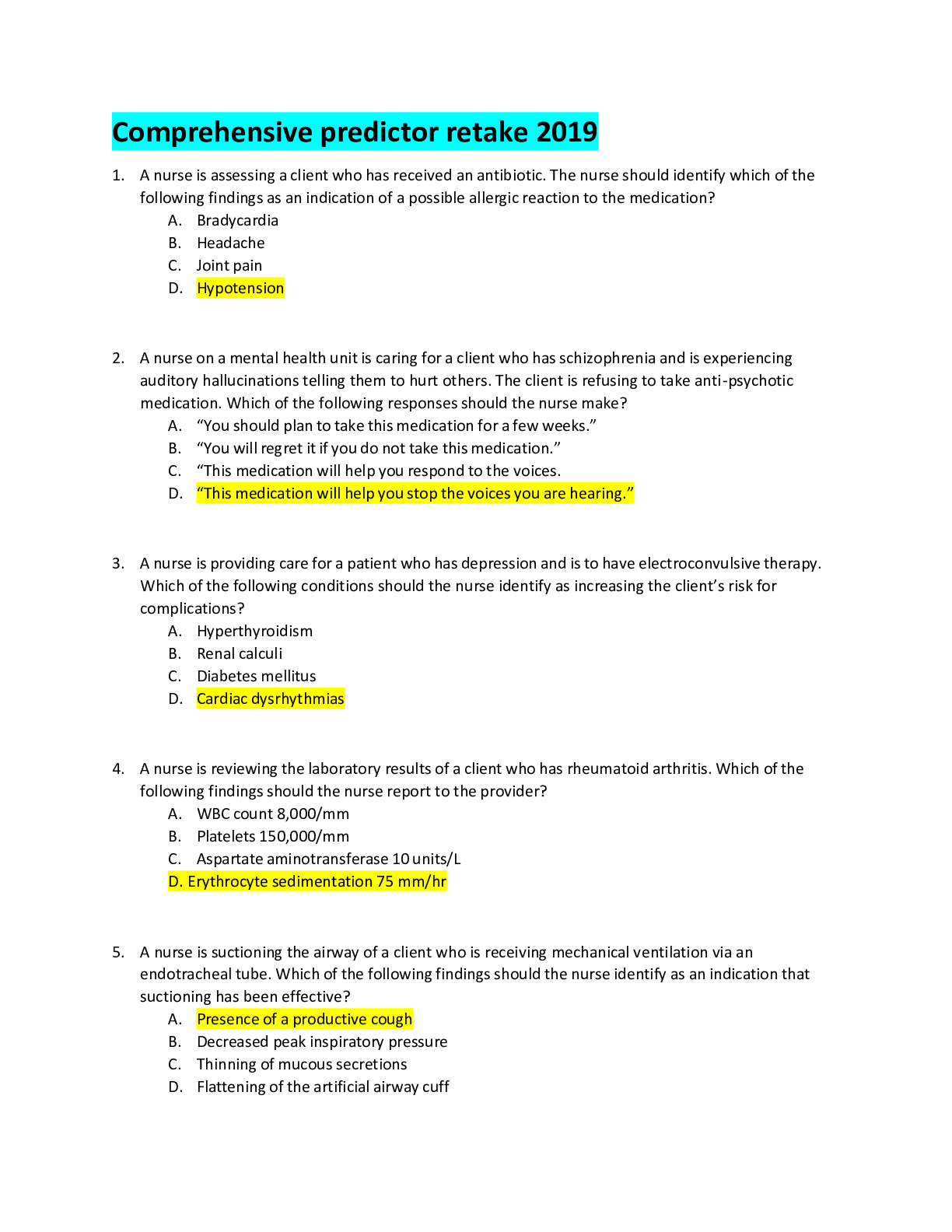
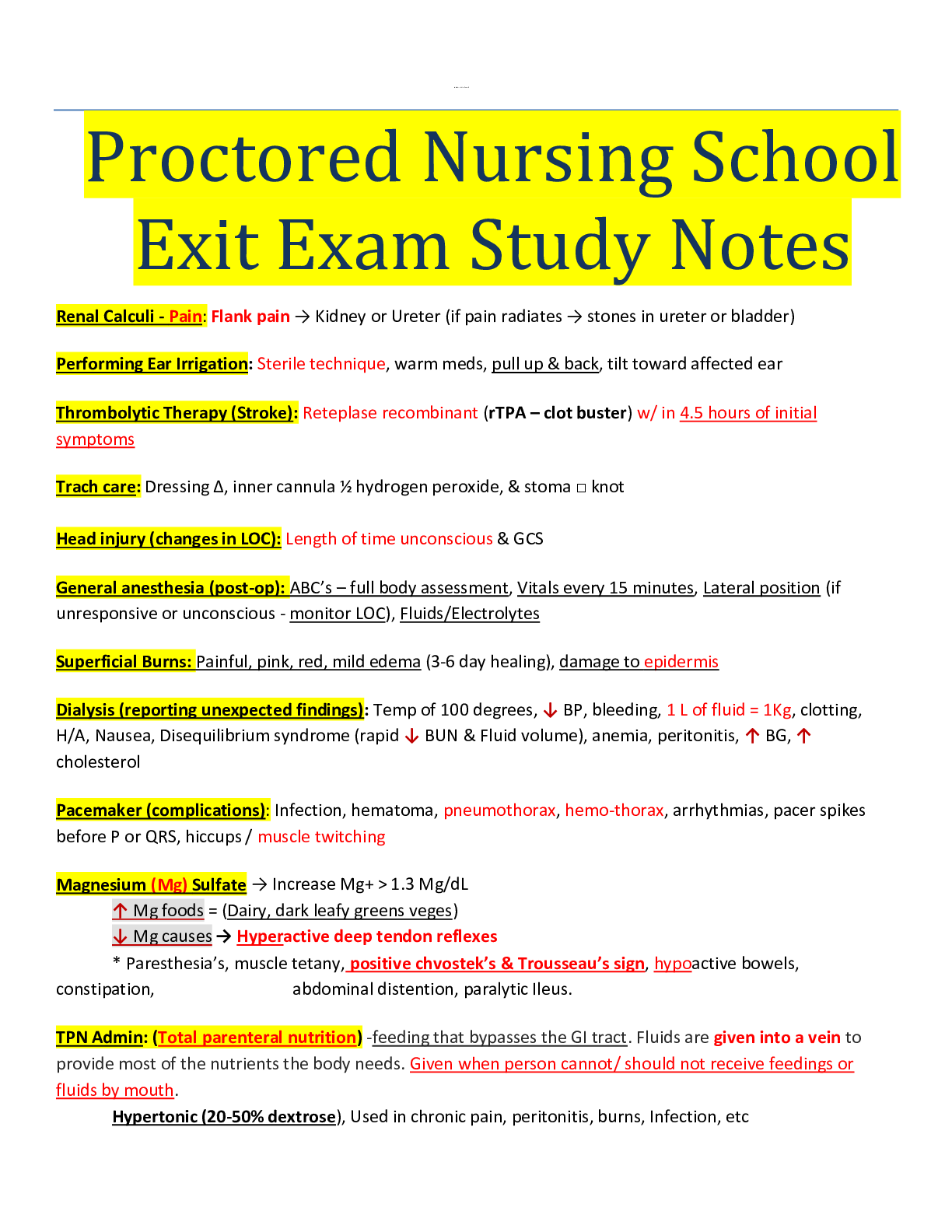
 (New 2020).png)
